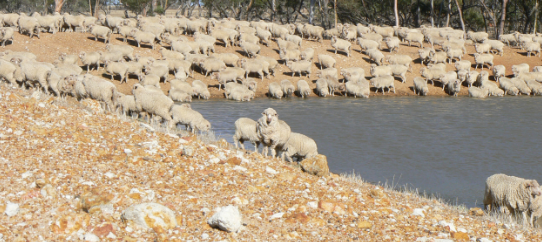Quality water is top priority for livestock
PRODUCTION ADVICE - MARCH 2020 - ANIMAL HEALTH
By Adrian Smith
Senior Land Services Officer,
Mixed Farming Systems
Ph: 03 5881 9932 | M: 0447 778 515 | E: adrian.smith@lls.nsw.gov.au
Providing adequate amounts of good quality water is the number one priority for livestock producers, particularly during hot weather.
Poor quality water can reduce productivity and compromise livestock health, while inadequate quantities can be even more devastating.
 Livestock will require extra water when:
Livestock will require extra water when:
- they are large or lactating
- they are feeding on dry feed or saltbush
- the drinking water is saline
- the weather is hot.
The quality of the water consumed by livestock also needs to be considered. There are many factors that will influence water quality, including:
- salinity
- pH
- nutrient imbalances (especially nitrogen, phosphorus, chloride, iron etc)
- blue-green algae
- faecal contamination and pathogens
- toxic residues and compounds
- water temperature
- turbidity.
Many producers may be facing problems caused or worsened by runoff from fire- and/or drought-affected land, blue-green algae in many of our waterways, and reliance on (sometimes) poorer-quality groundwater.
Landholders should review the NSW DPI Primefact ‘Water requirements for sheep and cattle’ to obtain a better understanding of their livestock’s water requirements - https://www.dpi.nsw.gov.au/__data/assets/pdf_file/0009/96273/Water-requirements-for-sheep-and-cattle.pdf
I recommend you get a water sample tested if you are unsure or concerned about the quality of your farm water supplies. There are many private laboratories that can test your water – alternatively, your local Local Land Services (LLS) or NSW DPI office have water test kits available.
Water quality impacts on livestock health and performance
Of interest is how water quality can influence livestock performance.
Work from Australia is not extensive, but studies from around the world document improved livestock performance where good quality water is available. Evidence suggests that livestock consuming good quality water can have production 10-25 per cent higher than if they were drinking poor quality water.
Dry matter intake is highly correlated to water consumption - that is, the more an animal drinks, the more it tends to eat (and vice versa). For example, one study reported that yearling heifers with access to clean water gained 23 per cent more weight than heifers with access to dam water only. It was also found that when dam water was pumped to a trough, it was preferred over the dam water, suggesting that cattle might prefer to drink from a trough and avoid entering a dam.
Apart from the direct impacts on productivity, animals drinking contaminated or poor-quality water may be more prone to disease and infection, resulting in poorer general health. Stock water can often be fouled by livestock themselves, native animals or runoff from surrounding areas – hot weather and low water levels worsen the problem.
This all suggests there is considerable potential to improve livestock performance by providing good quality water.
What can you do to improve water supply and its quality?
Given the consequences of poor quality water on animal health and production, now is as good a time as any to start planning how you could improve your farm’s water security.
In the short-term, you might consider how to improve the quality of runoff into any dams or waterways. This may include installing silt and sediment traps, which aim to slow the flow of water and trap debris and soil before it reaches a watercourse or dam. If runoff does enter your water supply and starts to cause problems, aeration is one of the best ways to improve the quality and increase palatability. Adding barley straw may also help improve water quality.
Longer-term, you may consider piped stock water, supplied through troughs coupled with some on-farm storage. It could also involve providing more watering points than you have now to better use paddock feed and reduce livestock walking.
There is a range of different options to consider, and many variables to think about, not the least of which is capital cost. However, don’t underestimate the benefits of a more secure, reliable and improved quality water supply system, not only to your livestock but also to your own peace of mind.
What assistance may be available?
A number of current programs are worth considering if you are contemplating capital investment in water infrastructure. These include:
1. Drought Assistance Fund - the NSW Government is offering a one-off $50,000 interest-free loan to transport stock, fodder and water, genetic banking of breeding herds and installing on-farm fodder and water infrastructure. The loan's term is seven years, and there are no repayments required in the first two years.
2. Farm Innovation Fund - the NSW Government is offering a loan scheme for capital works up to a value of $250,000 for infrastructure works (including water storage and infrastructure) to prepare for dry conditions, build resilience and improve on-farm efficiency.
3. On-Farm Emergency Water Infrastructure Rebate - the Australian and NSW governments are offering a rebate to drought-affected farmers who invest in urgently needed on-farm water infrastructure. Farmers will be able to access a 25 per cent rebate on new purchases and installation costs of water infrastructure projects on-farm across NSW to help them in the current drought and be better prepared for future dry conditions.
4. Regional Investment Corporation Low Interest Loans - the Australian Government is offering low-interest loans to help farmers prepare for, manage through and recover from drought (including water infrastructure).
Landholders are encouraged to go to the NSW DroughtHub website (www.dpi.nsw.gov.au/climate-and-emergencies/droughthub), or contact Murray Local Land Services or your local Rural Financial Counsellor for further information.